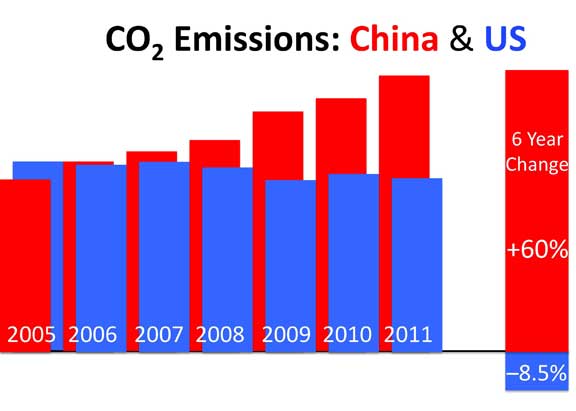Solar Power & Carbon Dioxide
US Cuts CO2 Emissions; World Doesn’t
I usually
report on astrophysics and cosmology, but I’m also interested in how
science impacts society. Not all black holes are in outer space.
The latest official report on energy-related carbon dioxide emissions from 2005 to 2011 roused my attention.
The United States reduced CO2 emissions 8.5%.
But at the same time, worldwide CO2 emissions increased 15.3%.
The decline of U.S. CO2 tonnage equaled the combined reductions by all other nations that did reduce CO2 emissions. It turns out not many nations reduced CO2 emissions.
Other significant emission reducers, by percentage, were Canada (-11%), Europe (-7.8%), and Japan (-4.9%).
The
greatest CO2 emission increasers were China (+60%), India (46%), the
Middle East (+35%), South Korea (+24%), and Russia (+13%).
China
accounted for 75% of the world’s increased CO2 emissions. China now
emits 27% of the world’s CO2, and its per capita emissions are 38% above the world average.

The U.S.
Department of Energy Information Administration compiled these data in
accordance with UNFCCC standards. They say energy-related CO2 emissions
account for 98% of our total emissions. The sources are electricity
generation (38%), transportation (31%), industrial (14%), residential
(6%), commercial (4%), and many smaller categories.
A major
factor in emissions reductions in developed countries was the recession,
the greatest economic downturn since the Great Depression. Increased
energy efficiency and greater use of natural gas instead of coal helped
reduce U.S. emissions. Natural gas produced 30% of U.S. power in 2011,
up from 19% in 2005.
By contrast,
CO2 emissions dramatically increased in developing countries,
particularly China and India, due to the rapid expansion of coal-fired
power plants; one is shown below. They burn coal because that’s the
cheapest way to make electricity.

In 2011,
China invested $52 billion in renewable energy, much of that to support
its own solar panel manufacturers. Solar is an industry China is
determined to dominate on a worldwide basis.
The U.S.
spent $51 billion that same year on renewable energy, much of that
subsidized the purchase of solar panels made in China. Thus, both
nations’ large investments are fostering Chinese dominance of this
growth industry.
With their
government and our government’s support, the Chinese have undercut all
other solar panel makers. They have the additional benefits of cheaper
labor, cheaper electricity (from burning coal), and far less
environmental regulation.
My wife and
I just put solar panels on our roof, shortly after our neighbor removed
a huge tree that shaded our house. We didn’t buy the panels; we bought
the power they will generate over the next 20 years. After government
subsidies, we’ll pay 7.8¢ per kilowatt-hour, which is less than half of
the 18.0¢ we paid before. But, there’s one key difference: our 7.8¢ is
fixed for 20 years, while everyone else’s rates will go up each
year. Our rate may one day be only 10% of what our neighboring
will be paying. Plus, the 7.8¢ is our guaranteed maximum rate; if our
panels generate more power than guaranteed, we’ll get the excess power
for free.
I expect to
pay only 25% of the cost of all the electricity that we’ll use for the
rest of our lives. Who’s picking up the other 75% of the tab? Three
guesses — every other American who buys electricity or pays taxes.
Part of
this money comes from federal taxes, part from state taxes, and part
from everyone’s utility bills. On last year’s bills, I noticed a charge
called “conservation incentives allowance” that amounted to 1/6 of our
total bill.
Frankly,
I’m embarrassed that you’ll be paying our bills. This is welfare for
people who can afford a roof. But that’s our government’s policy. We’d
be crazy not to accept the windfall.
Instead of
subsidizing China and roof owners, our government could have spent the
same funds to build large solar facilities with American-made
components, and sold the power at favorable prices to our utility
companies. That way every consumer would have benefited, and there’d be
more American jobs.
We got our
system from a “U.S.” company. When the panels arrived, I checked the
labels; the solar wafers were made in Taiwan and the panels were
assembled in China. Only the salesman and the installers were American.
Is this what you want your taxes and electric bills used for?
Best Regards,
Robert
May 7, 2013
P.S. The
Los Angeles Times just reported that electric car maker Telsa Motors
will receive tax credits of $250 million this year from the State of
California; that's $35,000 per car. California voters approved tax
increases in the last election. I wonder if they knew they were paying
$35,000 for each Telsa customer who could afford an $80,000 car? Surely
there are better ways to serve the public good.
Note: Previous newsletters can be found on my website
|